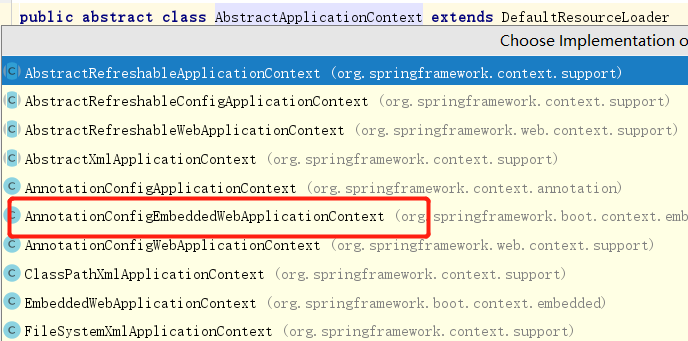打开源代码过程略去不谈,找到入口方法之后发现有两次调用,而我们实际需要开始关注的是下面这个方法。
public static ConfigurableApplicationContext run(Object[] sources, String[] args) {
return (new SpringApplication(sources)).run(args);
}可以看到首先调用了有参构造方法,然后调用run(String[] args)进行后续操作。
构造方法中需要关注的是initialize()方法,其中跟此启动内置Tomcat相关的则是deduceWebEnvironment()这个方法,从命名可以得知此方法用于判断当前是否为Web环境。
//项目初始化
private void initialize(Object[] sources) {
if (sources != null && sources.length > 0) {
this.sources.addAll(Arrays.asList(sources));
}
//确定是否是Web环境
this.webEnvironment = this.deduceWebEnvironment();
this.setInitializers(this.getSpringFactoriesInstances(ApplicationContextInitializer.class));
this.setListeners(this.getSpringFactoriesInstances(ApplicationListener.class));
this.mainApplicationClass = this.deduceMainApplicationClass();
}
//跟Web环境相关Class
private static final String[] WEB_ENVIRONMENT_CLASSES = new String[]{"javax.servlet.Servlet",
"org.springframework.web.context.ConfigurableWebApplicationContext"};
//判断是否web环境 只有数组中的Class全部存在才会判定为Web环境
private boolean deduceWebEnvironment() {
String[] var1 = WEB_ENVIRONMENT_CLASSES;
int var2 = var1.length;
for(int var3 = 0; var3 < var2; ++var3) {
String className = var1[var3];
if (!ClassUtils.isPresent(className, (ClassLoader)null)) {
return false;
}
}
return true;
} 构造方法完成之后则是run(String[] args)方法。
public ConfigurableApplicationContext run(String... args) {
StopWatch stopWatch = new StopWatch();
stopWatch.start();
ConfigurableApplicationContext context = null;
FailureAnalyzers analyzers = null;
this.configureHeadlessProperty();
SpringApplicationRunListeners listeners = this.getRunListeners(args);
listeners.starting();
try {
ApplicationArguments applicationArguments = new DefaultApplicationArguments(args);
ConfigurableEnvironment environment = this.prepareEnvironment(listeners, applicationArguments);
Banner printedBanner = this.printBanner(environment);
//创建ApplicationContext
context = this.createApplicationContext();
new FailureAnalyzers(context);
this.prepareContext(context, environment, listeners, applicationArguments, printedBanner);
//刷新Context
this.refreshContext(context);
this.afterRefresh(context, applicationArguments);
listeners.finished(context, (Throwable)null);
stopWatch.stop();
if (this.logStartupInfo) {
(new StartupInfoLogger(this.mainApplicationClass)).logStarted(this.getApplicationLog(), stopWatch);
}
return context;
} catch (Throwable var9) {
this.handleRunFailure(context, listeners, (FailureAnalyzers)analyzers, var9);
throw new IllegalStateException(var9);
}
}其中跟启动内置Tomcat相关的则是createApplicationContext()与refreshContext(context)方法,第一个方法大家顾名思义,功能在此不过多解释。下面是它的具体实现。
//创建AnnotationConfigEmbeddedWebApplicationContext
protected ConfigurableApplicationContext createApplicationContext() {
Class<?> contextClass = this.applicationContextClass;
if (contextClass == null) {
try {
contextClass = Class.forName(this.webEnvironment ? "org.springframework.boot.context.embedded.AnnotationConfigEmbeddedWebApplicationContext" : "org.springframework.context.annotation.AnnotationConfigApplicationContext");
} catch (ClassNotFoundException var3) {
throw new IllegalStateException("Unable create a default ApplicationContext, please specify an ApplicationContextClass", var3);
}
}
return (ConfigurableApplicationContext)BeanUtils.instantiate(contextClass);
}可以看到,其主体是一个基于this.webEnvironment变量的判断,此处我们获取到的ConfigurableApplicationContext的具体实现是AnnotationConfigEmbeddedWebApplicationContext。然而Tomcat是在哪里启动的呢?接下来让我们看下refreshContext(context)的实现。
private void refreshContext(ConfigurableApplicationContext context) {
this.refresh(context);
if (this.registerShutdownHook) {
try {
context.registerShutdownHook();
} catch (AccessControlException var3) {
;
}
}
}
protected void refresh(ApplicationContext applicationContext) {
Assert.isInstanceOf(AbstractApplicationContext.class, applicationContext);
((AbstractApplicationContext)applicationContext).refresh();
}可以看到,其首先调用的refresh方法,而在此方法中,applicationContext被转形为AbstractApplicationContext,然后调用了其中的refresh()方法。
打开源码瞄两眼,原来是个抽象类。嗯,依赖抽象而不是实现。再看下依赖关系,

AnnotationConfigEmbeddedWebApplicationContext赫然在列。稍微看下refresh(),其中关键是onRefresh()这个方法。
/**
* Template method which can be overridden to add context-specific refresh work.
* Called on initialization of special beans, before instantiation of singletons.
* <p>This implementation is empty.
* @throws BeansException in case of errors
* @see #refresh()
*/
protected void onRefresh() throws BeansException {
// For subclasses: do nothing by default.
}但是我们在AnnotationConfigEmbeddedWebApplicationContext其实是没有找到关于onRefresh()的实现的。那父类呢?我们可以看到其是继承于EmbeddedWebApplicationContext的,观察下其关于onRefresh()的具体实现。
protected void onRefresh() {
super.onRefresh();
try {
//创建Web容器
this.createEmbeddedServletContainer();
} catch (Throwable var2) {
throw new ApplicationContextException("Unable to start embedded container", var2);
}
}从命名可以看出,这里是真正Tomcat开始创建的入口,其实现如下:
private void createEmbeddedServletContainer() {
EmbeddedServletContainer localContainer = this.embeddedServletContainer;
ServletContext localServletContext = this.getServletContext();
if (localContainer == null && localServletContext == null) {
EmbeddedServletContainerFactory containerFactory = this.getEmbeddedServletContainerFactory();
this.embeddedServletContainer = containerFactory.getEmbeddedServletContainer(new ServletContextInitializer[]{this.getSelfInitializer()});
} else if (localServletContext != null) {
try {
this.getSelfInitializer().onStartup(localServletContext);
} catch (ServletException var4) {
throw new ApplicationContextException("Cannot initialize servlet context", var4);
}
}
this.initPropertySources();
}至此,Spring boot内置ServletContainer启动流程完成。其流程如下: